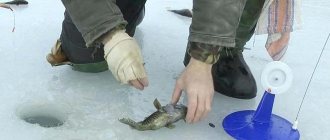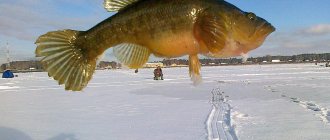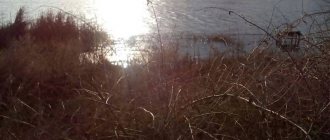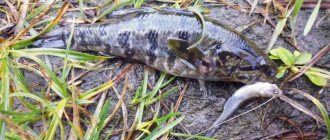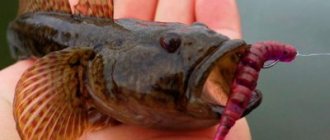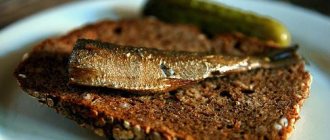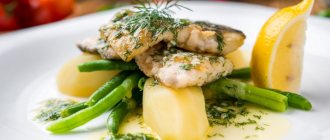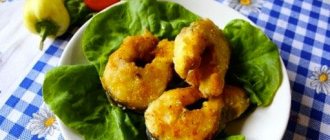- Wild animals
- >>
- Fish
The type of fish rotan is a little unusual, most of its body is made up of a large head and a huge mouth, it is not for nothing that it is called a firebrand. The appearance of rotan seems unattractive to many, but its taste properties can compete with any other more noble fish. Let's try to understand all the nuances of the life activity of this fish predator, characterizing its appearance, habits and disposition.
Origin of the species and description
Photo: Rotan
Rotan belongs to the ray-finned fish from the firebrand family; it is the only one that represents the firebrand genus. Rotan is a perch-like fish, it is also called grass or firebrand. Somewhere closer to the second half of the last century, the name Amur goby was attached to this fish. Of course, rotan is very similar in appearance to a goby, but calling it that is incorrect, because it has nothing to do with their family.
Not many people know how to distinguish a goby from a rotan, so it’s worth paying attention to this. The differences lie in the ventral fins: in the grass fin they are paired, rounded and small, while in the goby they are fused into one rather large sucker.
Rotan was brought from the East. It has taken root perfectly in the new conditions, literally occupying many bodies of water, displacing other fish. Perhaps this happened because the firebrand is very hardy, unpretentious in food, one might even say, indiscriminate, the vitality of this fish is simply amazing. If there are no other predatory fish in the reservoir, then voracious rotans can completely destroy roaches, dace and even crucian carp. Apparently, that’s why they are also called live-swallowers.
Video: Rotan
Rotan is distinguished by its huge head and huge insatiable mouth; they occupy almost one third of the fish’s entire body. Rotan is unpleasant to the touch, because... his entire body is covered with mucus, which often emits a not very pleasant aroma. In general, this fish is not large in size; a standard rotan weighs about 200 grams. Specimens weighing half a kilogram are very rare.
Rotan can be confused with a goby, but it differs significantly from other fish, having an unusual appearance, the features of which we will try to understand.
What kind of fish, where is it found, description
Rotan is one of the most widely occurring representatives of ray-finned fish species on the European Peninsula. It can be attributed to the firebrand subfamily.
The herb is quite small in size. But that doesn't stop her from being a predator. She eats virtually all living things that she encounters along the way. But for large species, rotan itself serves as prey.
The length of mature rotan specimens with sufficient nutrition can reach 15–25 centimeters. The average weight of the fish is about 500 grams.
The lifespan of rotan is approximately 4-5 years. The grass grass head is disproportionately large relative to the body, its mouth resembles the huge teeth of a predator.
Another feature is the short body. Fish changes color depending on environmental conditions. But brown, greenish and gray tones predominate. There are inclusions of small spots and stripes.
Rotan is able to withstand difficult living conditions. It remains viable in severe frosts. Moreover, they feel quite comfortable in conditions where other freshwater fish die.
The firebrand prefers reservoirs in which there are no competitors, small water pools with stagnant water. Then the fish feels absolutely safe and begins to multiply rapidly. Rotan easily tolerates even slightly salted water and dry rivers.
Rotans feed on leeches, tadpoles, eggs of other fish and small fish. True, for such large fish as perch or pike, firebrands often become prey themselves. This is what fishermen take advantage of when rotans are used as bait for larger fish.
Rotan has spread throughout the basins of virtually all rivers in Europe; it lives in the Ob, Lena, and rivers of the Urals. This river predator can be found in the waters of China and Korea.
Appearance and features
Photo: Rotan fish
The body of rotan is very massive, knitted, but not long; in addition to mucus, it is densely covered with medium-sized scales.
The color of rotan is very variable, but the following tones predominate:
- grey-green;
- dark brown;
- dark brown;
- black (in males during spawning).
In a reservoir with a sandy bottom, rotan has a lighter color than the one that lives in wetlands. During the mating season, males turn completely black (it’s not for nothing that they are nicknamed “firebrands”), while females, on the contrary, become lighter in color.
The coloring of the firebrand is not uniform; it has characteristic lighter spots and small stripes. The belly of the fish is almost always dirty gray in color. The length of the fish’s body can be from 14 to 25 cm, and the largest weight can be up to half a kilogram, although this is very rare; rotan is usually much smaller (about 200 g).
A large head with a huge mouth equipped with small, needle-like teeth is the calling card of this fish predator. By the way, the firebrand’s teeth are arranged in several rows, and the lower jaw is slightly elongated. They (teeth) have the ability to change to new ones at certain intervals. The bulging eyes of the fish are set quite low (right at the very upper lip). On the gill cover there is a spine-like process looking back, which is typical of all perciformes. A characteristic feature of rotan is its soft fins that do not have spines.
Two fins are noticeable on the rotan's ridge, the rear of which is longer. The anal fin of the fish is short, and the pectoral fins are large and rounded. The tail of the firebrand is also rounded, and there are two small fins on the abdomen.
Where does rotan live?
Photo: Rotan in water
At first, rotan had a permanent residence in the Far East of our country, in North Korea and northeast China, then it appeared in the waters of Lake Baikal, which scientists accepted as biological pollution of the lake. Now the firebrand has spread widely everywhere, thanks to its endurance, unpretentiousness, ability to stay for a long time without oxygen, adaptability to different temperature conditions and their fluctuations, and ability to live in heavily polluted waters.
Rotan is found throughout our country in various bodies of water:
- lakes;
- rivers;
- ponds;
- reservoirs;
- wetlands.
Now rotan can be caught in the Volga, Dniester, Irtysh, Ural, Danube, Ob, Kama, Styr. The firebrand prefers floodplain reservoirs, between which it settles during floods. She does not like too fast currents and prefers stagnant water, where there are no other predatory fish.
Rotan loves dark muddy waters where there is a lot of vegetation. In those places where predators such as pike, asp, perch, catfish live in abundance, rotan does not feel comfortable, its numbers there are either completely insignificant, or this fish does not exist at all.
In the first half of the last century, people released rotans into reservoirs located on the territory of St. Petersburg, then they settled en masse throughout the northern part of Eurasia, Russia and various European countries. On the territory of our country, the habitat of rotan runs from the border with China (Urgun, Amur, Ussuri) to Kaliningrad itself, the Neman and Narva rivers and Lake Peipsi.
What does rotan eat?
Photo: Rotan
Rotans are predators, but the predators are very voracious and insatiable, spending most of their time in search of food. The vision of firebrands is very sharp; they are able to distinguish moving prey from afar. Having seen a potential victim, the rotan follows it slowly, with short stops, helping itself only with small fins located on the abdomen.
When hunting, rotan has tremendous calm and equanimity, moving smoothly and measuredly, as if thinking about what maneuver to take, and his intelligence does not let him down. Newborn rotan fry first eat plankton, then small invertebrates and benthos, gradually starting to feed like mature relatives.
The menu of an adult rotan is very diverse; he is not averse to snacking:
- small fish;
- leeches;
- newts;
- frogs;
- tadpoles.
Grassweeds do not refuse eggs and fry of other fish, which often causes great damage to its population. In small bodies of water, where there are no other predators, sleeper breeds very quickly and can kill other fish, which is why anglers don’t like it. Firebrands do not disdain all kinds of carrion, eating it with great pleasure.
Rotan often eats without measure, absorbing prey in huge quantities. His huge mouth can accommodate fish with a volume to match his size. An overfed rotan almost triples in size, then it sinks to the bottom and can remain there for several days, digesting what it has eaten.
Cannibalism flourishes among rotans, when larger individuals eat their smaller counterparts. This phenomenon is especially developed where there are a lot of these fish.
It is worth noting that sometimes rotan is specially released into a heavily stocked reservoir. For example, in a pond where crucian carp has proliferated and become smaller, rotan reduces its population, thereby helping the remaining fish grow to larger sizes. We can say that rotan is unpretentious when it comes to food and eats almost everything it catches, literally gorging itself to satiety.
Catching Rotan
Fishing for it is very exciting, it readily bites on all animal baits, and does not disdain plant baits. For spinning rods he prefers small silicone attachments.
Rotan is practically not afraid of noise, in fact, it even attracts him. It takes the bait greedily and swallows it deeply. The bites are sharp.
Features of character and lifestyle
Photo: Rotan fish
Rotan can be called an active, almost always hungry, and therefore aggressive predator. It would seem that he can adapt to any, even the most unfavorable living conditions. The unpretentiousness and endurance of rotan are simply amazing. Rotan remains alive even when the reservoir freezes to the very bottom. It also tolerates severe dry periods with success. This miracle fish avoids only fast currents, preferring secluded, overgrown, stagnant, often swampy waters with a muddy bottom.
Rotan is active all year round and continues to be caught both in winter and summer. Hunger overcomes him in any weather; his appetite drops slightly only during the mating season. If in the winter cold many predators form flocks and go in search of warmer places, then rotan is no different in this behavior. He continues to hunt alone. Only severe frosts, leading to freezing of the reservoir, can encourage rotans to unite in order to survive.
Ice does not form around such a flock of firebrands, because... the fish secretes special substances that do not allow it to freeze, it falls into torpor (anabiosis), which stops with the first warming, then rotan returns to normal life. Sometimes during wintering rotans sink into silt and remain motionless for months. Rotans use the same technique during severe drought, being not only under a layer of silt, but also in a capsule of their own mucus, which helps them survive natural disasters.
Rotans are also not afraid of all kinds of pollution; even bleach and ammonia do not particularly affect them. They not only live in very dirty water, but also continue to reproduce successfully. The vitality of rotan is amazing; in this regard, it outperformed even unpretentious crucian carp. A rotan can live for about fifteen years, but usually its lifespan is from 8 to 10 years. This big-headed predator is so exclusive and unusual.
Social structure and reproduction
Photo: Little rotan
Rotan becomes sexually mature when it is closer to three years of age; spawning takes place in May-July. At this time, both females and males transform: the male turns into a noble black color, a certain growth stands out on his wide forehead, and the female, on the contrary, acquires a lighter color so that she can be easily seen in turbid water. Mating games can last for several days.
In order for rotan to begin active reproduction, the water must warm up from 15 to 20 degrees plus.
The number of eggs laid by one female reaches a thousand. They have a yellowish tint and a slightly elongated shape, equipped with a very adhesive thread stem to firmly attach to aquatic vegetation, snags, and stones lying at the bottom. For spawning, the female chooses a secluded place so that as many fry as possible can survive. The male becomes a faithful guard, protecting the eggs from the attacks of any ill-wishers.
Seeing the enemy, the rotan begins to fight, ramming him with its massive forehead. Unfortunately, rotan is not able to protect its future offspring from all predators. For example, he can rarely cope with large perch. In addition to guard duties, the male performs the function of a kind of fan, fanning the eggs with the help of fins, because they need much more oxygen than mature individuals. Thus, a current is created around them and an influx of oxygen occurs.
Despite the fact that the male takes such tireless care of the eggs, when offspring emerge from them, he can eat them himself without a twinge of conscience, this is explained by the struggle for the survival of the fittest and the practice of cannibalism among rotans. It is worth paying attention to the fact that the grass can live in slightly salty water elements, but spawns only in freshwater. The predatory breed of sleeper is visible immediately; already on the fifth day after birth, the larvae begin to feed on zooplankton, gradually enlarging the size of their prey and switching to the diet of adults.
Growing fry hide in dense underwater growth because they feel that they can become a snack not only for other predators, but also for their closest relatives, including their parents.
Reproduction of rotan
Amur sleeper firebrands reach full sexual maturity approximately in the second or third year of life. The active spawning period begins from May to July. The average female of the only representative of the firebrand genus is capable of laying up to one thousand eggs. At the spawning stage, males not only turn a characteristic black color, but also acquire a peculiar growth that appears in the frontal area. Females of Perccottus glenii, on the contrary, are characterized by a light, white color during the spawning period, thanks to which mature individuals become very visible in turbid waters.
Rotan eggs are distinguished by their oblong shape and yellow color. Each egg has a thread stem, which ensures a very strong and reliable fixation on the bed. Since all the eggs hang freely and are constantly washed by water, their viability rates increase significantly. All eggs laid by the female are constantly guarded by the male, who is ready to defend his offspring and actively protect them from any other aquatic predators. However, if rotans can quite successfully defend themselves against the encroachments of verkhovka or ruffe, then such an aquatic predator has unequal chances with perch and very often loses.
After rotan larvae begin to hatch en masse from the eggs, quite often the offspring are swallowed by the male himself - this is a kind of struggle of individuals of different ages for survival. Firebrands are able to live even in slightly salted water, but the spawning process can only take place in fresh water bodies. It is very interesting to observe the life, as well as the reproduction and habits of rotan in aquarium conditions. In captivity, the habits of a typical predator appear, which hides among vegetation and attacks its prey with lightning speed.
Important! The optimal conditions for active reproduction of the only representative of the genus of firebrands are the presence of a water temperature within 15-20°C.
Natural enemies of rotans
Photo: Rotan fish
Despite the fact that rotan itself is an insatiable and always active predator, it also has enemies and does not sleep. Among them are pike, catfish, snakehead, asp, perch, eel, pike perch and other predatory fish. In those reservoirs where any of the listed predators are found, rotan does not feel at ease and its numbers are not at all large; in these places, the firebrand rarely grows more than two hundred grams.
Do not forget that rotans themselves happily eat each other, acting as enemies of their own relatives. Naturally, the most vulnerable are the eggs and fry of rotan, which often serve as a snack for all kinds of water beetles, especially predatory bugs, which are difficult for even mature fish to cope with.
Of course, among the rotan’s enemies one can also name a person who not only hunts for it with a fishing rod, but also tries to remove it from many reservoirs where the rotan has proliferated greatly. Many commercial fish suffer from rotan, which can completely displace them from their inhabited territory. Therefore, experts take various measures to reduce the number of rotan in a given body of water, thereby protecting other fish. Scientists believe that if no measures are taken on this matter, then there will be no one there to catch except rotan with a fishing rod.
Can it be eaten?
Even 100 years after the fish appeared, people ask: “is it edible or not?” The answer is yes .
Rotan is not very tasty, its beneficial properties of meat are regarded as dietary. Another advantage is that the predator has few bones. You can cook fish with any dish; it goes perfectly with rice.
Fried rotan
You can clean rotan from scales with a regular knife. Removing the insides is easy. After cutting, it is recommended to soak the rotan in cool water and cut off the fins. This will get rid of the smell of swamp and mud. Rotan meat is dense, since rotan is a predator and is used to hunting a lot for prey.
To learn more:
What is bleak and where does it live?
Cooking recipes
Under the marinade
Boil the meat and remove the bones. Cut into pieces and arrange evenly on a plate. Grate the carrots on a coarse grater and cut the onion into small cubes. Fry carrots and onions with tomato paste and spices to taste. Pour the marinade over the boiled rotan meat and let it stand in the refrigerator for two hours.
Balloons
Pass the pre-cooked rotan carcass through a meat grinder. Mix the resulting mass with mashed potatoes, 1 to 1. Add egg, butter and spices. Form the balls into the desired shape and roll in breading. You can fry it on the stove, or stew it in a saucepan.
